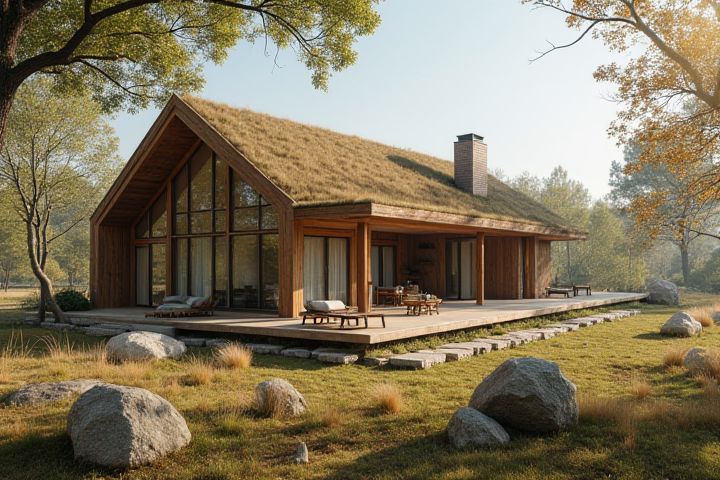
Sustainable houses typically utilize eco-friendly materials such as bamboo, reclaimed wood, and recycled metal, which minimize environmental impact while providing durability. Insulation made from natural fibers like hemp or cellulose enhances energy efficiency, reducing heating and cooling costs. Windows with triple-glazing and low-energy coatings optimize natural light and thermal performance, contributing to a comfortable indoor climate. Employing solar panels and rainwater harvesting systems further promotes self-sufficiency and lowers reliance on nonrenewable resources. By choosing these sustainable materials, you can significantly reduce your home's carbon footprint while enjoying a healthy living environment.
What Materials Build A Sustainable House
Bamboo
Bamboo is a highly sustainable building material, noted for its rapid growth rate, which can exceed 35 inches per day, making it an incredibly renewable resource. Its strength-to-weight ratio is remarkably high, often outperforming steel, giving structures excellent durability while remaining lightweight. Additionally, bamboo acts as a carbon sink, absorbing approximately 48 tons of carbon dioxide per hectare per year, contributing to environmental sustainability. When considering your sustainable house, integrating bamboo not only supports eco-friendly practices but also offers unique aesthetic qualities, with its natural textures and versatile applications in construction.
Reclaimed Wood
Reclaimed wood is a key material in building a sustainable house, offering both environmental benefits and aesthetic appeal. Sourced from old barns, factories, and warehouses, reclaimed wood reduces the demand for new lumber, thus conserving forest resources and minimizing deforestation. This type of wood also typically boasts a rich history and unique character, with variations in color and grain that can enhance the overall design of your home. Furthermore, utilizing reclaimed materials can contribute to earning LEED credits, making your project more appealing to eco-conscious buyers or renters.
Recycled Steel
Recycled steel serves as a durable and environmentally friendly building material in sustainable house construction. Comprising about 30% of the world's steel production from recycled sources, this metal significantly reduces energy consumption and greenhouse gas emissions during manufacturing. Furthermore, steel's longevity--often exceeding 50 years--ensures that structures withstand the test of time while minimizing the need for maintenance and replacement. Incorporating recycled steel into your home's framework can also contribute to LEED certification, enhancing energy efficiency and sustainability ratings.
Hempcrete
Hempcrete, a biocomposite made from the inner fibers of the hemp plant, mixed with lime, is an eco-friendly building material that offers excellent insulation properties. This lightweight material has a carbon-negative footprint, sequestering approximately 110 kg of CO2 for every cubic meter produced. Hempcrete is also mold-resistant and provides excellent humidity regulation, contributing to healthier indoor air quality. When combined with other sustainable materials like reclaimed wood and solar panels, your home can achieve high energy efficiency and sustainability ratings.
Straw Bales
Straw bales, a key component in building sustainable houses, offer excellent insulation properties, with an R-value of around 30 to 35 per inch, making them highly energy-efficient. These bales are primarily made from agricultural residues, which means they are renewable and contribute to reduced waste by repurposing leftover stalks from crops like wheat and rice. Structures utilizing straw bales not only exhibit a low carbon footprint due to minimal energy consumption for heating and cooling but also provide soundproofing benefits, creating a quieter indoor environment. Integrating straw bales into your building design can lead to substantial energy savings, with many homeowners reporting reductions in energy bills of up to 50%.
Cork
Cork is an exceptional material for building sustainable houses due to its renewable nature and efficient insulation properties. Harvested from the bark of cork oak trees without harming the tree, cork is biodegradable and contributes to carbon dioxide absorption, making it an eco-friendly choice. Its natural resilience and water resistance improve a home's energy efficiency by reducing heating and cooling costs. Incorporating cork flooring, insulation, and wall coverings not only promotes sustainability but also adds a unique aesthetic appeal to your living space.
Earth
Sustainable houses often incorporate materials that have a low environmental impact and promote energy efficiency. Earth-based materials, such as rammed earth, adobe, and cob, are excellent choices due to their natural abundance and thermal mass properties, allowing for effective temperature regulation. Recycled materials, like reclaimed wood and recycled steel, can further reduce resource consumption while enhancing the structure's aesthetic. By using non-toxic finishes and insulation options, such as sheep's wool or cellulose, your sustainable home can also improve indoor air quality and comfort.
Recycled Plastic
Recycled plastic serves as a versatile building material in sustainable houses, providing durability and resistance to weathering. In particular, some companies utilize post-consumer recycled plastic to create insulation boards, roofing shingles, and structural components, significantly reducing landfill waste. Utilizing recycled plastic not only conserves resources but also saves energy, as manufacturing from recycled materials typically consumes 70% less energy compared to virgin materials. When constructed with recycled plastic, your sustainable home can boast a lower carbon footprint while contributing to a circular economy.
Solar Panels
Sustainable houses often utilize solar panels as a key component for renewable energy generation, significantly reducing reliance on fossil fuels. Typically made from silicon, these panels convert sunlight into electricity, with an efficiency range of 15% to over 22% in high-performance models. Incorporating energy-efficient insulation materials such as cellulose, hemp, or spray foam can further enhance your home's energy conservation. Additionally, installing energy-saving windows and using recycled materials for construction helps create a holistic approach to sustainability.
Adobe
Adobe is a traditional building material made from natural elements like clay, sand, and straw, offering remarkable thermal mass that helps regulate indoor temperatures. This sustainable approach utilizes local resources, minimizing transportation emissions and promoting environmental harmony. When combined with features such as green roofs and energy-efficient systems, adobe houses can achieve significant energy savings, potentially reducing heating and cooling costs by up to 30%. By incorporating renewable energy sources like solar panels, you can further enhance the sustainability of your adobe home while lowering your carbon footprint.
